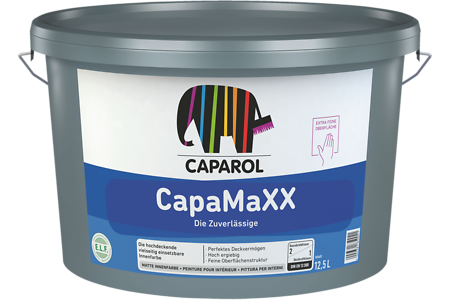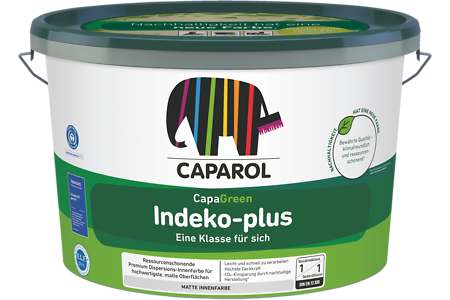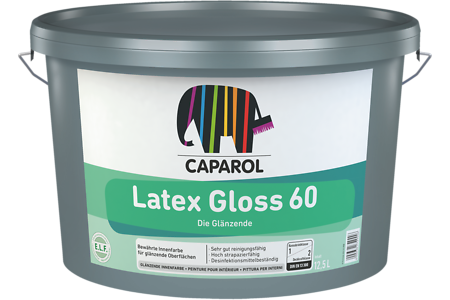Field of Application
Capaver glass fleeces provide for highly attractive, high-grade and individual wall surfaces, due to variations in texture, type, colour shade, gloss level and application technique of topcoats.In accordance with the expected degree of stress or desired visual appearance, all glass fleeces may easily be coated with suitable paint materials and efficient renovations are possible, due to individual needs.
Material Properties
- Easy to renovate: Recoatable without any pre-treatment.
- Non-swelling, rot proof, dimensionally stable.
- Crack bridging.
- Eco-friendly dressing.
- Highly moisture resistant.
- Fire behaviour according to DIN 4102 depending on coating A2 or B1.
- Classified according to OEKO-TEX® Standard 100.
Material Base / Vehicle
Capaver glass fleeces (glass non-woven) are made of specially developed, purely mineral glass yarns.Types that can be delivered
| Type / Product Name | Texture | Weight per m2 | Roll Size |
| AkkordVlies G130 VB | fine–medium | Approx. 130 g | 50 x approx. 1 m |
| AkkordVlies G190 VB | fine–medium | Approx. 190 g | 25 x approx. 1 m |
Packaging/Package Size
See table above. Selectable unit: One carton per roll.
Storage
Keep Capaver glass fleeces in a dry place.Mass per unit area
Surface weight / See table above (Weight per m2).
Supplementary Product
- Capaver CapaColl VK
- Capaver CapaColl GK
Note
Capaver glass fleeces are made of glass fibres with a diameter > 5 µm and are therefore not respirable. Despite the highest level of integration of the glass fibres, they can be released to a very limited extent when the nonwovens are cut to size and cause itching in people with sensitive skin, which subsides once the bonding work is complete. In principle, no more glass fibres are released after coating.
For medium requirements and a white to slightly tinted coating with a matt interior paint, one coat is usually sufficient. Depending on the colour tone, gloss level, surface stress, light situation and surface appearance requirements, two coats may be necessary. In principle, the agreed service between the contractor and client applies. A test coating is recommended in advance.
Structural cracks cannot be repaired with Capaver AkkordVlies G130 VB and G190 VB.
Suitability according to Technical Information No. 606 Definition of Application Areas
| Interior 1 | Interior 2 | Interior 3 | Exterior 1 | Exterior 2 |
| + | + | ○ | – | – |
| (–) inapplicable / (○) of limited suitability / (+) suitable | ||||
Substrates
Interior surfaces made of mineral plasters of mortar groups PI, PII and PIII, gypsum plasters and finished plasters of mortar group PIV, gypsum plasterboard, gypsum boards, concrete surfaces.
High-contrast substrates such as concrete filigree ceilings must be primed with Caparol HaftGrund EG, other substrates must be tested in advance.
Substrate Preparation
The substrate must always be solid, dry, sound/stable, clean, even and free from separating substances. Follow Technical Information No. 860. In Germany: Follow VOB, part C, DIN 18366, section 3. Lower temperature limit for application and drying: +5 °C (product, substrate and ambient air).Note Q2/Q3 levelling / thin layers of gypsum < 0.5 mm
When using gypsum-based, hydraulically setting levelling compounds in quality level Q2/Q3, a transparent, water-based primer is recommended. Please refer to the Maler&Lackierer Merkblatt Nr. 2 -9/2020 "Haftfestigkeitsstörungen von Beschichtungen auf verspachtelten Gips(karton)platten" des Bundesverbandes Farbe, Gestaltung, Bautenschutz und des Bundesausschusses Farbe und Sachwertschutz.
As an alternative to gypsum-based Q3 levelling, levelling with pasty levelling compounds has proven itself.
Method of Application
Adhesive (Glue):
Roller Application:
- Apply CapaColl VK or GK evenly with a roller (18 mm piles), but only for 1 - 2 lengths, depending on the temperature on site.
- Caution! Take particular care to ensure that the adhesive is distributed as evenly as possible, as accumulations of adhesive under the fabric can have a negative effect on the final surface appearance.
Spray Application:
- A minimum of 3 workmen on the job is required.
- CapaColl VK can directly be applied to the wall with suitable airless equipment.
- Dilute CapaColl GK with 20 % of tap (potable) water, depending on the conditions on site.
- Important: It is suggested to observe the recommended material consumption and to spread the adhesive (glue) evenly, avoiding a surplus of applied product.
- Advice: Detailed information concerning the spray application of CapaColl are given within our German manual #843604 "Handbuch der Spritztechnologie".
Embedding/bonding of glass fabrics and fleeces:
- The reverse side of the roll is marked (if provided) and has to be bonded to the wall. To avoid structural differences, never glue inverted or upside down.
- We recommend butt bonding for the fleeces, although all glass fleeces can also be processed with a double seam cut.
- Caution! The sheets must be tightly joined in the seam area. However, this must not lead to a bulge in the joint area and therefore a poor seam appearance.
- The glued strips are then pressed onto the substrate with a wallpapering trowel or a pressure roller, applying sufficient pressure to ensure that the entire surface is covered and bubble-free. Cut off any excess with the wallpapering trowel while fixing the edges.
- Tip! When bonding around external corners, make sure that the membrane is guided at least 10 cm around this corner. The formation of external corners can be made considerably easier by using special plastic corner profiles that significantly improve impact protection (e.g. commercially available profiles from HoBus, DLW, Protector, etc.). Bonding is carried out with assembly adhesives that ensure correctability. The resulting height differences should be levelled with dispersion filler (gypsum-based fillers are not suitable). The use of Caparol-Akkordspachtel fein bzw. mittel or AkkordLeichtspachtel is recommended here. Always prime plastic profiles and levelling areas with Capadecor DecoGrund or Caparol HaftGrund EG.
Surface Coating System
Intermediate Coat:The intermediate coat forms the basis for a perfect final coat. After the wall covering has dried, the intermediate coat is applied to match the final coat.
Finishing Coat:
The selection of a suitable top coat depends on the required degree of stress and gloss. Coatings should always be applied wet-on-wet. This also applies to trimming areas.
Drying/Drying Time
Allow bonded lengths of glass fleeces to dry thoroughly before any further coating.
Note
Capaver wall coverings are thoroughly inspected by the manufacturer. In exceptional cases isolated production related weaving faults may occur. These faults are marked at the trimmed edges and correspondingly compensated. They do not entitle to any objection.
While cutting the fleeces, ascertain whether there are no weaving faults.
Claims based on material deficiency cannot be objected after the application of more than 10 lengths.
On principle the marked interior side of a roll has to be bonded to the wall. The outer side of the roll is the visible face. To avoid differences of appearance in texture/pattern, always place the fleeces running in one direction and not laterally inverted. In case of complaint the label with the batch and product numbers must be kept ready.
German Certificates
Test certificates and expertises- Flame-retardancy according to German standard DIN 4102, B1
- Non-combustibility according to German standard DIN 4102, A2
- Decontaminatibility in combination with Disbopox 447 E.MI Wasserepoxid
- Classified according to OEKO-TEX® Standard 100
| Fire behaviour classification associated with Capaver AkkordVlies G 130/190 VB | |
| Coating | Reaction to fire: Class |
| CapaTrend | A2 |
| Malerit E.L.F. | A2 |
| CapaMaXX | A2 |
| Indeko-plus | A2 |
| CapaSilan | A2 |
| Sylitol Bio-Innenfarbe | A2 |
| Latex Samt 10 | A2 |
| Latex Satin 20 | A2 |
| Latex Gloss 60 | A2 |
| Nespri®Silan | B1 |
| SeidenLatex | B1 |
| PremiumClean | B1 |
| Disbopox 447 E.MI Wasserepoxid | B1 |
All test certificates and expertises can be downloaded from www.caparol.de in the download area of the respective product.
Disposal
Materials and all related packaging must be disposed of in a safe way in accordance with the full requirements of the local authorities. Particular attention should be made to removing wastage from site in compliance with standard construction site procedures.
In Germany: Dispose Capaver Glass Fabrics and Fleeces as construction site waste.
Technical Assistance
All substrates encountered in practice and their technical processing cannot be dealt with in this publication. If substrates are to be treated that are not listed in this technical information, it is necessary to consult us or our sales representatives. We will provide you with detailed and object-related advice.Customer Service Centre
Tel.: +49 6154 71-71710Fax: +49 6154 71-71711
e-mail: kundenservicecenter@caparol.de
International Distribution: Please see www.caparol.com















